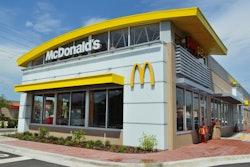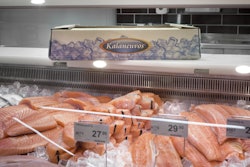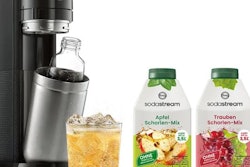Packaging World:
The last time we spoke, you said one of the primary drivers for Dell’s development of more sustainable packaging was a demand from your customers—including large corporate and enterprise customers as well as consumers—to see more environmentally friendly packaging. Is this still the case?
Oliver Campbell:
Oh absolutely. When you look at the cultural trends out there, sustainability and care for the planet are growing ever stronger. When it comes to our sustainability efforts—whether it’s in packaging or closed-looped recycling, where we recycle plastics, or the use of waste carbon fiber in some of our notebooks—our customers continue to be very excited and are asking for more. In fact, many of them are asking to benchmark off of what we do. It’s a really good feeling.
Consumers today are very conscious of what they see as overpackaging of product. Do you ever feel their expectations around sustainable packaging are unrealistic?
No, I don’t think they’re unrealistic. I think what customers want is a better world. They want a great experience. They want it at a great cost. I don’t think those are unreasonable things. The business that can figure out how to deliver those things is going to have the advantage. That’s what we’re trying to do at Dell—to satisfy the customer’s requirements, to delight the customer in those requirements, and to have them feel that by purchasing Dell products, they’re part of a sustainability solution, that they’re doing good for the planet. Obviously, we’re not there yet in every regard, it’s a bit of a journey, but that’s our destination.
Are you also seeing other drivers, such as regulations or cost savings?
Yes. You mentioned the “C” word. Nobody wants to talk about costs. Let me dive into that one. The key principal we’ve operated under, really since we began using bamboo in 2009, was that if we were to use innovative packaging materials, they had to be at cost parity or better [than traditional packaging materials]. For us, it was never about sustainability costing more. It’s about sustainability leading the way to the future. And it does that by being greener, and through cost savings. We’ve continued to drive down the cost of our packaging through sustainability innovation. It’s pretty exciting that when sustainability is done right, it can be great for business, great for people, and great for the planet.
I wonder if, back when sustainability became the buzzword and everyone was talking about adopting green packaging, the cost really put a damper on their efforts.
That could’ve been the case years ago. And sustainability was very niche; it was very new. I think it only appealed to a certain market segment at the time. As the science and research, and the public demand for it have all increased, the cost curve has shifted to where it’s much more favorable. It still can be difficult for sure, but we’re seeing more and more companies come into this space with new materials and new ideas, and we’re just happy to have been a part of that at the very beginning.
When we spoke last, Dell was in the process of performing Life Cycle Assessments (LCAs) on its products and packaging. Since then, have you determined how much of your carbon footprint is attributable to packaging?
We’re taking another look at the LCA footprint. A lot has changed since we first talked, and I’m not sure that work is necessarily still relevant. The packaging though tends to be a small part of the product’s footprint when you look at the overall logistics. That’s something we’re doing another assessment on.
Our main focus has been around materials: Are they sustainably sourced, and can we sustainably dispose of them through recycling or composting, which is Mother Nature’s way of recycling. That’s been our main emphasis, and that’s been driven through customer feedback.
Over the years, Dell has been at the forefront of innovation when it comes to packaging materials, including the use of bamboo, mushroom roots, wheat straw, and air, to name a few. Is Dell still using these materials?
We phased out some. We have an inactive portfolio, and as we’ve innovated, some have declined in use. So they spiked up and then came down. Bamboo is an example of that. Just last week, we switched the packaging for our XPS 13 2-in-1 notebook—our top-of-the-line notebook—from bamboo to ocean plastic.
Ocean plastic is our latest innovation. In June, Dell made a commitment to the United Nations at The Ocean Conference that by 2025, we will increase our use of ocean plastic 10-times over what we’re using this year. That’s a pretty audacious goal. We also committed—and this is really important—to being open source with our supply chain so others can utilize it and be part of the solution around ocean plastic as well. This will even include competitors. We’re hoping others will join us in this effort.
What inspired Dell to develop a supply chain around ocean plastic?
It’s a good story. We have a social good advocate. His name is Adrian Grenier. He’s an actor most well-known for his work on the TV show Entourage. Around two years ago, we had a brainstorming session with him. He has a passion for oceans. He started the Lonely Whale Foundation. We began talking about what we could do to improve the health of the oceans. The topic of ocean plastic quickly came up, and we began talking about how we could potentially use this material. We were intrigued by it, because we have a pretty good track record of packaging innovation, and we’re pretty good with our supply chain expertise.
So we started asking ourselves how we could bring sustainable packaging innovation and supply chain expertise together to help solve a really pressing global problem, and do it in a way that would be cost-effective and also commercially scalable so that businesses would be attracted to using these materials. That was the genesis of the idea. From there, we’ve spent probably the last year to 18 months doing a more detailed assessment, then validation, and finally a pilot. The result has been that we’re now shipping our XPS 13 in ocean plastic, and we’re busy looking at other products within the Dell portfolio that can use this packaging. We’re also talking to other companies about joining us in this effort.
What part of the computer’s packaging is being made from ocean plastic?
The notebook is shipped inside a gift box. Inside that gift box is a tray upon which it rests. The tray is made from high density polyethylene. Seventy-five percent of that is made from post-consumer recycled HDPE, and the other 25% is made from ocean plastic that we intercepted before it reached the ocean. We pulled the plastic out of streets, canals, and rivers before it got to the ocean. To explain why we believe it’s important to gather plastics from these areas, we use the analogy that if your bathtub is flooding, the first thing you do is turn off the faucet and stop the flow.
Where we’re most focused is on stopping the flow of plastic that’s bound for the ocean, before it’s swept into the sea and then really starts to do damage. That’s also probably the most economical place to collect it. Those two things line up very well for us.
How do you make it economically feasible to collect these materials?
When you look at where most ocean-bound plastic originates, 60% of it comes from Southeast Asia—countries such as the Philippines, Indonesia, Thailand, Southern China, and Vietnam. These countries are often characterized, particularly in the urban areas of high population density, by lack of potable water and lack of any type of waste management. So, the plastics just get discarded on the ground, and then they’re swept into the sea. This is resulting in a budding industry of collecting bottles and other plastics.
After collection, the plastics are cleaned and sorted, and then recycled. What we’re trying to do is continue to encourage this type of infrastructure, because hopefully, someday, we’ll be out of this business. It is my hope that the waste management infrastructure will be put in place, and we won’t have this issue of plastic being swept into the sea. And at that point, we’ll go on and innovate around something else.
Are you investing in the collection or recycling infrastructure? Or are you just encouraging the process?
We’re working with local recyclers; we’re watching those supply chains and learning about them. I think there are going to be a number of issues around how that’s done, and we want to take a very thoughtful approach to how that portion of the supply chain is engaged with. We are talking with people in our own company as well as outside experts about how best to do that.
Another way to intercept plastic waste before it gets to the ocean is by educating consumers on how to recycle. Is Dell engaged in any initiatives around recycling?
We have a great computer takeback program through Goodwill. It’s not oriented around packaging; it’s oriented around the product itself. Any consumer in the U.S. as well as in 81 countries and territories can take a computer back, whether it’s from Dell or from one of our competitors, and that computer will be recycled. Depending on the age of the computer, they will do certain things with it [such as use the material for new computers or donate them to schools or hospitals]. The program is a way to drive a circular economy and reuse what are very valuable materials.
We created the program to help ensure we’re not creating e-waste problems in third-world countries, or even second-world countries, with our products. Dell takes that very seriously. Currently we’re on track to collect over 2 billion pounds of recycled material by 2020. It’s a phenomenal success story. It highlights the commitment from our Chairman and CEO, Michael Dell, and the entire company to circular economy principals—they’re not only good for the planet, we think ultimately they’re good for business too.
Regarding Dell’s sustainable packaging commitments, one is to make sure your packaging can be recycled or composted. In the U.S., there is not much of a composting infrastructure. Is this something that’s more relevant in other countries where you do business?
Yes. In Europe there’s much more of a composting infrastructure. In the U.S., it’s been slow to evolve. We’ve looked at compostable material technologies; our mushroom packaging fits into that category. It also checks off our commitment around the sourcing of material, being sustainably sourced. In the case of the mushroom packaging, the material is sourced from agricultural waste.
In Dell’s 2016 Corporate Social Responsibility Report, it mentions that Dell spent 2014 and 2015 overcoming hurdles related to the development of a production-oriented supply chain for mushroom packaging. Was this a matter of getting the supplier, Ecovative, up and running?
Yes, they had to scale their operations. They had some technical challenges, which they successfully overcame. We are now using mushroom-based cushioning for our Dell PowerEdge 13G R430 server product. It’s funny you mention the mushroom packaging. I have a bunch of mushroom samples here in my office that we’re working on. The really the interesting thing with sustainable packaging is that it continues to rapidly evolve. We continue to see new things. Ocean plastic is a great example. This is why I’m so bullish on packaging and so happy to be in this industry.
From my perspective, one of the most interesting technologies you introduced was the AirCarbon carbon-neutral plastic material made from air and GHGs. It’s so unique.
Again, that was a case of starting out with a very small company, in this case Newlight Technologies, and helping nurture them and grow their technology. Dell feels this in their DNA—Michael Dell started the company in his dorm room at the University of Texas. When smaller companies develop a hot technology, and especially within packaging, we want them to come talk with us at Dell. They’ll find a good reception, because we were there once ourselves.
One thing I have not seen Dell adopt is drop-in bioplastics. Is this something you’re considering?
Yes, we continuously evaluate those technologies. That’s probably the most I can say about that.
Can you summarize Dell’s progress in meeting its sustainability goals?
Our goal for 2020 is to have 100% of our packaging be recyclable or compostable. At the beginning of the life cycle, we want 100% of our packaging to be sustainably sourced. Currently we’re about 94% of the way to our target. That’s calculated on ETEP (EPA-Tribal Environmental Plan) basis.
The 100% started out as an aspirational goal, but I believe we’re going to get there. You must have aspirational goals, because if it’s less than that, everyone wants to be the exception. We’re really trying to drive big change, and I think we’re going to get there by 2020. It’s taken a lot of work by some great packaging engineers on this team to get us this far. We also have great suppliers that work well with us.
Is there one technology or innovation that has had the biggest impact on meeting those goals.
Yes. It’s funny, we use a lot of molded paper pulp. That has really lifted our numbers. We’re doing things with molded paper pulp that four years ago would have been inconceivable. What really started it off was our innovation in bamboo fibers. That was a big breakthrough, not only for us, but also for the industry. We were able to make cushions out of bamboo. It’s a bit humorous, but in hindsight, the characteristics of bamboo, its tensile strength and fiber length, really compensated for a lot of our ignorance. We just didn’t know about the role of geometry and some of the processing techniques involved. But bamboo is really what triggered our move, and the industry’s move, into fiber and fiber cushioning.
As we gained experience with fiber and continued to innovate in that area, we got more efficient, and costs came down dramatically. Now we’re using a lot of molded paper pulp. It’s really had a tremendous impact on helping us meet our goals.
What is something you’re doing with molded paper pulp that would’ve been inconceivable before?
We’re using it for several of our desktop platforms. We use it for packaging our big All-in-One PCs. You see it now with our flat-panel monitors. When we first started out, we were using molded pulp with notebooks, which are fairly light. Over the last several years, we’ve been able to increase the performance of molded paper pulp so it can take heavier and heavier weights. That’s been the innovation. That’s one of those quiet innovations you don’t hear much about.
That’s interesting, because molded pulp is not as exciting or sexy as packaging made from bamboo or air.
That’s right.
But it does the job.
It does. I think it’s a sign of how accepted sustainability has become. When people see molded pulp packaging, they don’t even give it a second thought anymore. It’s like, this is what it should be like. They know they can go and recycle it. You can put it in your recycling bin at home and feel good about it. I’d say that’s a positive thing.
Is there something currently on your radar that looks really exciting for the future of sustainable packaging?
I’d say ocean plastic is it, and how we scale it. The ability to scale ocean plastic is tremendously exciting. That’s why we’re creating an open-source supply chain, and that’s why we’re asking others to join us. If you think about collaboration, there have been some examples in the industry before. The use of ocean plastics can even extend to other industries. That’s going to be phenomenal. I’m just happy to be a part of it.
Dell at the forefront
Learn more about Dell’s innovation around sustainable packaging in these articles from Packaging World magazine:
· “Dell adds ocean plastics to its packaging,” March 2017
· “Inspired by nature: Dell debuts plastic made from air,” September 2014
· “Dell: ‘Powering the possible’ of green,” September 2012
· “Protective packaging that’s grown,” June 2011
· “Bamboo cushion for Dell hardware is certified compostable,” May 2010


























